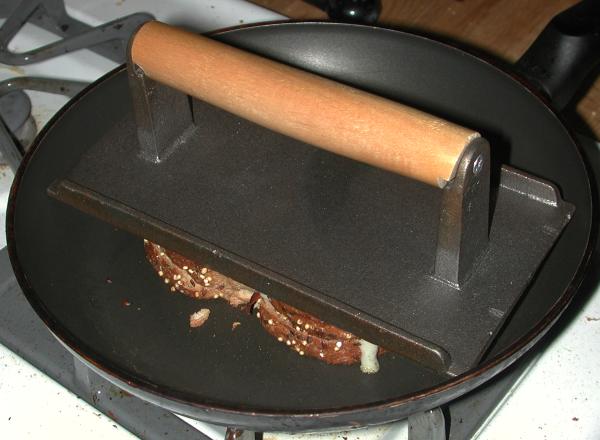|
Back to Recipes List 'Gredients: Bread, two slices per unit
Prebuild: Lightly apply the "oil" to one side of each slice of bread. It should scraped so it is fairly thin, for best results while sauteeing. The first slice of bread is placed on the prebuild plate oily side up, the second slice is place oily side down, and then the cheese is layered on this unoiled top surface. This prebuild stack is then continued vertically for as many iterations as is desired resulting sandwiches. The cheese layer should be constructed so as to mostly cover the entire bread slice, and can be as thick or thin as desired. Cooking: Cooking can start as soon as there are enough sandwiches in the prebuild stack to fill up the cooking surface. One should have a nicely preheated, non-stick pan at a medium low heat level - it should be just barely hot enough to make the oil sizzle when placing the sandwich on the surface. Too hot and the cheese will not melt properly; too cool and it will take too long to adequately brown the outer surfaces. This is easiest to achieve on a gas stove, or with an electric frying pan set to about 325 degrees F. Remove the top slice of oiled bread, with its accompanying cheese layer, from the prebuild stack. Place it neatly on the cooking surface. Remove the "oil side up" slice of bread that is now on top of the stack and place it oil side up on the cheese side of the sandwich you are building in the pan. The sandwich is cooked until the first side is a nice crunchy medium brown, then flipped to cook the other side. At the correct heat, this will result in the cheese being "just" melted - soft and gooey and hot, but not oozing out all over the place and burning on the pan. Weighting is often recommended in typical grilled cheese sandwich recipes - to the absurdity of wasting a sheet of aluminum foil and placing another pan on top of it. For years I have happily, successfully, and yummily built my grilled cheese sandwiches without any artificial pressure induced on the cooking delicacy. But, if you feel the need or desire to experiment, just buy a sandwich weight. I got mine from AceMart for about $10, to make my kitchen look cooler, along with a few other toys to defray shipping costs. This one has lots of little nubs, so it doesn't pick up too much oil from the uncooked side, and is easily wiped between sides. One thing it does do, if not pushed down hard to squoosh the sandwich, is speed upt he cooking a bit by reflecting heat back into the cooking delectables. Here is a chilled grease sandwich almost finished cooking, as you can tell by the melted cheese oozing out of one side:  This sandwich, as many do, exhibits a wide range of variations. The simple, basic, "diner" or "greasy spoon" version uses cheap, virtually tasteless white bread and a single processed cheese food slice. This version is helped a lot by weighting while cooking, since this makes it thinner and easier to handle while eating. The intermediate, and yummy, version, uses real food instead of the processed agrimechagarbage - tasty, whole grain breads and real cheese of the cook's choice. The "over-the-top" version, achieved by climbing the proverbial slippery slope backwards, comes about by adding other ingredients. A slice or two of bacon, or some tomato, may not seem to do much more than enhance the recipe, but at some point, say, adding a fried egg, some chili, and a grilled hamburger pattie, it's not really a grilled cheese anymore, it's a fried bacon egg and chili cheeseburger. The simplest step up from the diner version is to use a nice, flavorful white bread, such as Pepperidge Farms sandwich white, and "real" American style cheese, such as Land'o'Lakes white. The Yummy version uses the tasty multi-grain bread of your choice, like Pepperidge Farms Seven Grain, and block cheese, like Crackerbarrel Extra Sharp Cheddar, sliced appropriately. There are a number of things you can add and still call it a grilled cheese sandwich, in my opinion. One rule is not to add enough extras to move it into an already defined category, such as bacon, lettuce and tomato (a BLT), or corned beef and sauerkraut on rye ( a Reuben), or a burger pattie (a Hamburger). The simple, obvious tasties include such items as bacon slices (already cooked), slices of tomato (this makes a delightfully sloppy sandwich, and if the tomato is not heated too much, adds a nice temperature and texture contrast to the eating process), a little canned spaghetti sauce, pickle slices, or even potato chips. I recommend you go easy and experiment carefully with these extras - try one before committing to several sandwiches, remembering that most things you could add in the sandwich could also be served "on the side" to perfectly good effect. Serving suggestions: One to three per person, depending on the "weight" of the sandwiches and the diners appetite. Cut diagonally for a show of class, and remember to serve piping hot. Serve with a large glass of milk, and chips, pickles or dipping mustard on the side. Further varietal notes: I have seen quite a few recipes claiming to be for other named sandwiches that are nothing more than grilled cheese with five dollar names. If you fry two slices of oiled leavened bread with cheese between them, it's a Grilled Cheese! A quesadilla is not a grilled cheese, and neither are nachos. |
